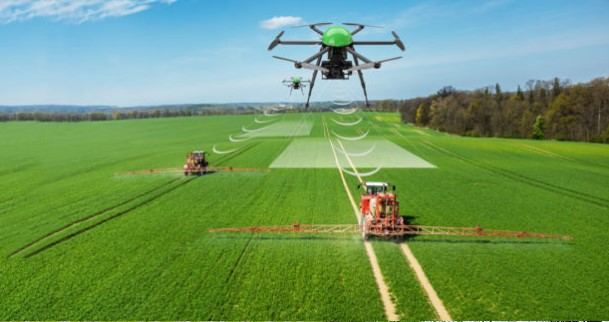E-TECHNOLOGY IN AID OF FARMERS
Introduction
- Indian agriculture is a cornerstone of the nation’s economy, ensuring food security, promoting sustainable development, and contributing significantly to poverty reduction. The integration of various technological revolutions and advancements has significantly transformed the agricultural landscape.
Evolution and Modernization of Indian Agriculture
Historical Advances
- The transformation of Indian agriculture began earnestly in the 1960s with the Green Revolution, introducing modern farming inputs such as high-yielding seed varieties, fertilizers, and irrigation facilities. This period marked the advent of significant government initiatives to enhance agricultural productivity through improved access to credit, mechanization, and marketing facilities. Subsequent revolutions, including the Blue (fisheries), White (dairy), and Yellow (oilseeds) Revolutions, further diversified and strengthened the agricultural sector.
Role of Biotechnology and ICT
- In recent years, the fields of biotechnology and information and communication technology (ICT) are revolutionizing the agriculture industry. These advancements enable the development of genetically modified crops, precision farming, and enhanced data management, offering solutions to traditional agricultural challenges.
Significance of Adopting E-Technology in Agriculture
- E-technology, encompassing digital and internet-based tools, plays a pivotal role in modernizing agriculture, addressing numerous challenges and opening up new avenues for development.
Remedial Therapy
- The Indian agriculture sector, plagued by issues such as water scarcity, pest infestations, and inadequate infrastructure, finds a lifeline in technological advancement. E-technology offers tools for efficient water management, pest control, and infrastructure development.
Development of Efficient Methods
- Advances in robotics, sensing technologies, and artificial intelligence contribute to more effective and efficient agricultural practices. These technologies facilitate precision farming, ensuring optimal resource utilization and minimizing environmental impact.
Enhanced Decision-Making and Planning
- Access to comprehensive information allows farmers to make informed decisions regarding crop selection, cultivation practices, and market strategies. E-technology tools enable precise monitoring of crop health, yield forecasts, and climate conditions, aiding in effective farm management and planning.
Disintermediation and Cost Minimization
- With the advent of e-technology, farmers gain direct access to markets and information, reducing reliance on intermediaries and minimizing transaction costs. This shift not only enhances farmers’ profitability but also promotes transparency and fairness in agricultural transactions.
Breaking Geographical Barriers
- Technology overcomes the limitations imposed by diverse agro-climatic zones in India, facilitating tailored agricultural practices and enabling access to information and markets across regions.
Community Participation and Transparency
- E-technology fosters community involvement and collective action in agriculture, ensuring equitable participation across the sector. Additionally, initiatives like Direct Benefit Transfer (DBT) and Aadhar-linked services enhance system transparency and reduce corruption.
USES OF E-TECHNOLOGY FOR FARMERS
- The integration of E-Technology into agriculture has revolutionized the way farming is conducted, offering myriad benefits to farmers across the globe. From improving productivity and enhancing crop resilience to facilitating better decision-making through data analytics, E-Technology stands as a cornerstone in modern agricultural practices.
Improved Productivity through Mechanisation
Agricultural Mechanisation
- E-Technology has led to the mechanisation of agriculture, significantly improving productivity, especially in tropical environments where manual labour and hand tools present limitations in energy and output. Mechanised farming equipment powered by E-Technology enables efficient land cultivation, planting, and harvesting, contributing to higher yields and reduced labor costs.
Agri-Extension and Farmer Services
Climate and Weather Prediction Using AI
- Artificial Intelligence (AI) and E-Technology tools collect and analyze data to support precision farming and informed decision-making. Drones, remote sensors, and satellites offer real-time insights into weather conditions, enabling farmers to plan and adapt their practices to ensure optimal crop growth and yield.
Resilient Crops via Biotechnology
- The use of biotechnology in developing resilient crops involves genetic engineering to improve resistance to pests and increase yields. By manipulating genes, biotechnology aids in creating crops that are better suited to withstand environmental stresses, contributing to food security and sustainability.
Agriculture Sensors
- Wirelessly connected sensors play a crucial role in modern agriculture, allowing for precise monitoring of soil composition, moisture content, and nutrient levels. These sensors enable targeted fertilizer application, reducing waste and enhancing crop growth efficiency.
Precision Farming and E-Training
Big Data for Improved Farm Yields
- The collection and analysis of big data in agriculture facilitate better decision-making across the supply chain. Smart farming benefits from big data analytics by identifying patterns and insights that lead to improved crop management and operational efficiency.
Livestock Monitoring
- E-Technology enables the monitoring of livestock health through body sensors and chips, identifying potential diseases early and preventing widespread infection within herds.
Skill Enhancement and Capacity Building
- E-Technology offers tools and platforms for e-training and demonstration, enhancing the skills and productive capacities of farmers. This ensures the cost-effectiveness, viability, and sustainability of farming practices.
Artificial Intelligence (AI) in Agriculture
Enhancing Crop Yield and Efficiency
- AI plays a critical role in addressing the challenges of increasing global population, land scarcity, and agricultural inefficiencies. Through AI, farmers can achieve higher productivity and yield on less land by optimizing crop growth conditions and management practices.
Scope and Opportunities for AI in Agriculture
- AI technology holds the promise of transforming the agricultural sector by improving the entire supply chain, from healthier crop production to pest control and soil monitoring. The global and Indian AI agriculture markets are expected to grow significantly, offering substantial opportunities for innovation and development.
Use of AI in Agriculture
- AI aids in analyzing farm data, enabling precision agriculture that identifies pests, diseases, and nutrient deficiencies. AI-powered agricultural robots can address labor shortages, performing tasks more efficiently than human laborers.
Initiatives Related to E-Technology in Agriculture
- The integration of e-technology in agriculture marks a significant leap towards modernizing farming practices, enhancing productivity, and improving the livelihoods of farmers across India. The government and various organizations have launched numerous initiatives to incorporate digital technologies into agriculture, aiming to create a more efficient, transparent, and sustainable agricultural sector.
National Agriculture Market (NAM)
- Launched during the 2014-15 budget, the National Agriculture Market (NAM) is a pan-Indian electronic trading platform that connects the existing Agricultural Produce Market Committee (APMC) markets and other market yards to form a unified national market for agricultural commodities. NAM facilitates virtual trading, where physical markets serve as the transactional back-end. It is implemented through the Agri-Tech Infrastructure Fund (ATIF) as a centrally sponsored scheme.
AGMARKNET
- The Agricultural Marketing Information Network (AGMARKNET), introduced by the Union Ministry of Agriculture in 2000, is aimed at enhancing the efficiency of agricultural marketing through the use of e-governance. Implemented by the National Informatics Centre (NIC), AGMARKNET’s portal facilitates the collection and dissemination of price and arrival information for agricultural produce, benefiting producers, consumers, traders, and policymakers alike.
E-choupal
- E-choupal is an initiative by ITC that provides farmers with alternative marketing channels, weather updates, information on agricultural practices, and input sales. Each E-choupal is equipped with a computer and internet access, managed by a trained village individual known as a “sanchalak.”
Direct Benefit Transfer (DBT) Central Agri Portal
- Launched in 2013, the DBT Agri Portal serves as a centralized platform for all agricultural programs in India, aiming to streamline and enhance the efficiency of government support to farmers through direct benefit transfers.
Village Resource Centres
- Village Resource Centres offer space-based services in rural areas, utilizing Earth Observation (EO) satellite data and Satellite Communication (SATCOM) networks to meet local needs and address challenges in villages.
Village Knowledge Centre (VKC)
- VKCs serve as information dissemination centers providing immediate access to the latest agricultural information and knowledge, from crop production to marketing. Each center is managed by a “VKC In-charge.”
Kisan Credit Card Scheme
- Introduced in 1998-1999, the Kisan Credit Card scheme leverages Information and Communication Technology (ICT) to provide Indian farmers with accessible and affordable credit, facilitating timely and adequate financial support.
National Mission on Agricultural Extension and Technology
- This mission aims to restructure and strengthen agricultural extension services to ensure farmers have access to the right technology and agronomic practices, enhancing productivity and sustainability.
Digital Agriculture Mission (2021–2025)
- The Digital Agriculture Mission focuses on promoting projects that employ cutting-edge technologies such as artificial intelligence (AI), blockchain, remote sensing, GIS, and robotics, including the use of drones in agriculture.
Unified Farmer Service Platform (UFSP)
- UFSP integrates data, applications, core infrastructure, and tools to ensure seamless interoperability among various IT systems within the national agricultural ecosystem, acting as a central organization similar to how UPI functions for e-payments.
AgriStack
- AgriStack, being developed by the Ministry of Agriculture and Farmers Welfare, aims to create a unified platform offering end-to-end services across the agricultural food value chain through technology-based interventions.
Sandesh Pathak
- This application, developed through collaboration among several Indian technology institutions, facilitates the reading of SMS messages aloud for farmers who may have difficulties reading.
Kisan Call Centre
- Launched in 2004, Kisan Call Centres leverage ICT to answer farmers’ queries in their own language, providing a direct channel for agricultural support and advice.
State-Level Initiatives Involving Farmers and Electronic Technology:
- eSagu: For small and marginal farmers, eSagu (Telugu word for cultivation in the Telangana Andhra Pradesh region) promptly offers personalised expert advice
from the sowing stage to harvest at their doorstep. The farm situation is presented to the expert using digital images and text data. Following a situational analysis, expert advice is prepared and given to the concerned farmer either that day or the next.
- AGRISNET: The AGRISNET project was conceived with the idea of building an interconnected, technologically enabled network to effectively provide informational services to the farming community. In order to efficiently and effectively provide informational services to the farming community, the project aimed to integrate cross-functional processes of the Department of Agriculture in Tamil Nadu.
- Jio Agri (JioKrishi) Platform: In 2020, a pilot project was launched in the Jalna and Nashik districts of Maharashtra. In order to empower farmers, it digitizes the agricultural ecosystem along the entire value chain.
Case Studies and Best Practices
| Initiative | Entities Involved | Year Started | Objective / Solution Provided |
| Sowing App | Microsoft, International Crop Research Institute for Semi-Arid Tropics | 2016 | Developed a sowing app to help farmers predict the right time for sowing crops, providing convenient access to sowing information. |
| SAMRAKSHANE | Karnataka Government | Not Provided | An end-to-end e-governance solution to handle crop insurance under Pradhan Mantri Fasal Bima Yojana (PMFBY) and the Modified Weather-Based Crop Insurance Scheme (MWBCIS). |
| Rashtriya e-Market Services | Karnataka State Government, NCDEX Spot Exchange | Not Provided | Encourages competition in agricultural markets to help farmers receive better prices for their crops by integrating technology and market access. |
| Plantix | Karnataka Government | 2018 | Launched an Android smartphone app capable of detecting pests, plant diseases, and nutrient deficiencies in crops, utilizing smart technology for agricultural benefits. |
| Meghdoot | Indian Government | Not Provided | A mobile application aimed at advancing the Digital India initiative by providing farmers with forecasts related to temperature, humidity, rainfall, wind speed/direction, and crop/livestock care. |
Challenges and Constraints in the Adoption of E-Technology in Agriculture
Lack of Infrastructure
- A significant barrier for farmers adopting new technologies is the lack of essential infrastructure. This includes a deficit in information regarding farm inputs, disorganized credit systems, and insufficient market linkages. These gaps hinder the efficient adoption and utilization of e-technology in agriculture, making it challenging for farmers to access and leverage new technologies for better productivity.
Appropriate Inputs and Advice
- Farmers often find themselves without sufficient knowledge of the various farming resources available to them. Moreover, there is a noticeable gap in the appropriate guidance on how to use these resources effectively. The lack of tailored advice and inputs specific to their needs limits farmers’ ability to optimize their operations with e-technology.
Poor Reach
- The reach of e-technology in agriculture is considerably limited, especially in rural areas. The overall distribution of technology across different regions is uneven, leaving many farmers without access to valuable agricultural innovations that could enhance their productivity and sustainability.
Lack of Access and Illiteracy
- The rapid development of electronic agriculture is significantly hampered in rural areas by a combination of factors including lack of connectivity, inadequate computer literacy, high service costs, and general illiteracy. These issues prevent rural communities from fully benefiting from e-technology advancements in agriculture.
Issues with Adoption
- Despite the clear advantages of new agricultural technologies, there is a noticeable reluctance or delay among farmers in adopting them. This hesitancy often stems from a lack of trust in new technologies and a preference for traditional methods that are perceived as more reliable.
Old Behaviour
- Elderly farmers, in particular, tend to rely solely on their experience and resist adopting new technologies. This resistance to change further compounds the challenges in integrating e-technology into traditional agricultural practices.
Financial Limitations
- While wealthier farmers may have the means to adopt and benefit from new technologies, small and marginal farmers often find themselves unable to afford these innovations. This economic divide exacerbates the accessibility issues surrounding e-technology in agriculture.
Content and Language Limitations
- A primary barrier to the use of information technologies in rural areas is the lack of content available in local languages. Although efforts are being made to address this issue, they are not sufficient to fully engage the population dependent on agriculture.
Way Forward
Develop the Concept of Smart Villages
- Fostering the development of smart villages can make rural communities more technologically savvy and environmentally sustainable. This includes enhancing post-management of crops and livestock, water use efficiency, mitigation of environmental impacts, carbon sequestration, and the use of clean fuels to improve productivity and adapt to climate change.
Intelligence Infrastructure
- The focus should be on developing financially viable and socially satisfactory approaches to technology that are accessible to the rural poor. This involves creating infrastructure that supports the effective use of e-technology in agriculture.
Boost Awareness
- It is crucial to ensure capacity building among rural communities, enabling them to use and maintain information and communication technology (ICT) effectively. This includes training and awareness programs tailored to the needs of these communities.
Communication Networks
- Improving communication networks can facilitate a more equitable, timely, and collaborative approach to market access for smallholders. This involves the integration of diverse ICT tools currently employed in agricultural practices.
Research and Innovations
- Sustained training is required to enhance interaction and the effective dissemination of knowledge using new digital technologies. This includes innovations in agricultural practices and the development of new technologies tailored to the needs of farmers.
Digitization of Academic and Research Data
- Academic and research data in agriculture, currently available in the form of journals and research papers, need to be digitized. This will facilitate the cross-flow of information and enhance the accessibility of valuable knowledge for farmers and researchers alike.
Linkage to Institutional Mechanism
- Establishing an institutional mechanism to link rural communities with universities and research agencies through intermediary organizations can significantly improve the adoption and implementation of e-technology in agriculture. This approach fosters collaboration and knowledge sharing, enhancing the overall impact of technology in rural farming practices.
UPSC PREVIOUS YEAR QUESTIONS
1. How can the ‘Digital India’ programme help farmers to improve farm productivity and income? What steps has the Government taken in this regard? (2015)
2. In the villages itself no form of credit organization will be suitable except the cooperative society.” – All India Rural Credit Survey. Discuss this statement in the background of agricultural finance in India. What constraints and challenges do financial institutions supplying agricultural finance face? How can technology be used to better reach and serve rural clients? (2014)










